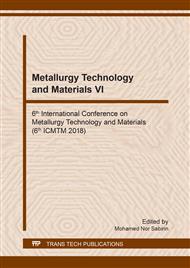[1]
J. Rosales, M. Cabrera, F. Agrela, Effect of stainless steel slag waste as a replacement for cement in mortars mechanical and statistical study, Const. Build. Mater. 142 (2017) 444-458.
DOI: 10.1016/j.conbuildmat.2017.03.082
Google Scholar
[2]
R. Salazar, J.M. Arcila, R. Gutierrez, Eco-efficient alkali-activated cement based on red clay brick wastes suitable for the manufacturing of building materials, J. Clean. Prod. 166 (2017) 242-252.
DOI: 10.1016/j.jclepro.2017.07.243
Google Scholar
[3]
M. Rabbani, R. Heidari, H.F. Asl, N. Rahimi, Using metaheuristic algorithms to solve a multi-objective industrial hazardous waste location-routing problem considering incompatible waste types, J. Clean. Prod. 170 (2018) 227-241.
DOI: 10.1016/j.jclepro.2017.09.029
Google Scholar
[4]
F. Wang, J.G. Song, M.H. Xu Effect of preparation technology on properties of quartz pore gradient materials using low-grade quartz sand, Key Eng. Mater. 697 (2016) 423-426.
DOI: 10.4028/www.scientific.net/kem.697.423
Google Scholar
[5]
J.G. Song, F. Wang, X.B. Bai, Effect of the sintering technology on the properties of fired brick from quartz sands, J. Ceram. Process. Res. 12(2011) 357-360.
Google Scholar
[6]
Q. Wan, F. Rao, S.X. Song, D.F.C. Gonzalez, N.L. Ortiz, Combination formation in the reinforcement of metakaolin geopolymers with quartz sand. Cement Conc. Comp. 80 (2017) 115-122.
DOI: 10.1016/j.cemconcomp.2017.03.005
Google Scholar
[7]
C. Udawattha, R. Halwatura, Life cycle cost of different Walling material used for affordable housing in tropics, Case Stud. Const. Mater. 7 (2017) 15-29.
DOI: 10.1016/j.cscm.2017.04.005
Google Scholar
[8]
M.T. Zhang, C. Chen, L.Q. Mao, Q. Wu, Use of electroplating sludge in production of fired clay bricks: Characterization and environmental risk evaluation, Const. Build. Materi. 159 (2018) 27-36.
DOI: 10.1016/j.conbuildmat.2017.10.130
Google Scholar
[9]
A.N. Adazabra, G. Viruthagiri, P. Kannan, Influence of spent shea waste addition on the technological properties of fired clay bricks, J. Build. Eng. 11 (2017) 166-177.
DOI: 10.1016/j.jobe.2017.04.006
Google Scholar
[10]
A. Ukwatta, A. Mohajerani, Leachate analysis of green and fired-clay bricks incorporated with biosolids, Waste Manag. 66 (2017) 134-144.
DOI: 10.1016/j.wasman.2017.04.041
Google Scholar
[11]
N. Phonphuak, S. Kanyakam, P. Chindaprasirt, Utilization of waste glass to enhance physical-mechanical properties of fired clay brick, J. Clean. Prod. 112 (2016) 3057-3062.
DOI: 10.1016/j.jclepro.2015.10.084
Google Scholar
[12]
S.H. Deng, R.D. Li, T.C. Yuan, S.Y. Xie, P. Cao, Direct current-enhanced densification kinetics during spark plasma sintering of tungsten powder, Script. Mater. 143 (2018) 25-29.
DOI: 10.1016/j.scriptamat.2017.09.009
Google Scholar
[13]
H.M. Wang, J.Q. Qi, Z.W. Lu, T.C. Lu, Q.Y. Wang, On the densification mechanism of nano grained yttrium aluminum garnet transparent ceramic during high pressure sintering process, Script. Mater. 142 (2018) 126-128.
DOI: 10.1016/j.scriptamat.2017.08.046
Google Scholar
[14]
J. Diatta, G. Antou, N. Pradeilles, A. Maître, Numerical modeling of spark plasma sintering- Discussion on densification mechanism identification and generated porosity gradients, J. Eur. Ceram. Soc. 37 (2017) 4849-4860.
DOI: 10.1016/j.jeurceramsoc.2017.06.052
Google Scholar
[15]
B. Conde, L.D. Vilarino, S. Laguela, P. Arias, Structural analysis of monforte lemos masonry arch bridge considering the influence of the geometry of the arches and fill material on the collapse load estimation, Const. Build. Mater. 120 (2016).
DOI: 10.1016/j.conbuildmat.2016.05.107
Google Scholar
[16]
X.X. Kong, Q.S. Liu, Q.B. Zhang, Y.X. Wu, J. Zhao, A method to estimate the pressure arch formation above underground excavation in rock mass, Tun. Underg. Space Tech. 71 (2018) 382-390.
DOI: 10.1016/j.tust.2017.09.004
Google Scholar


